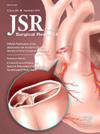黑色素瘤患者应切除多少前哨淋巴结?
IF 1.7
3区 医学
Q2 SURGERY
引用次数: 0
摘要
导言:许多早期黑色素瘤患者的治疗都包括前哨淋巴结(SLN)活检,以预测预后和制定治疗计划。虽然对其他恶性肿瘤患者进行前哨淋巴结活检所需的最低数量已经确定,但对黑色素瘤患者进行前哨淋巴结活检所需的最低数量尚未确定。目前的研究评估了SLN阳性的风险因素以及为进行适当分期而必须检查的相关SLN数量。材料和方法查询了2018年至2020年期间接受SLN活检的临床结节阴性患者的国家癌症数据库参与者用户文件。获得了描述性统计数据。进行了方差分析统计分析。结果 在2018年至2020年的48748名黑色素瘤患者中,确定了848名在SLN活检中淋巴结阳性的患者。患者年龄中位数为 64 岁。男女比例为 1.47。Chi-squared分析显示,在原发性黑色素瘤部位、男性性别(P <0.01)、种族、年龄、组织学类型、布瑞斯洛厚度和淋巴管侵犯(P <0.001)方面,至少两组之间的阳性率存在显著统计学差异(P = 0.006)。SLN阳性率随着检查的SLN数量的增加而增加,直到4个SLN时趋于平稳。3个SLN阳性率与检查的SLN数量之间没有统计学差异。倾向匹配显示,活检 2 个以上 SLN 时,阳性率无统计学差异。结论 SLN 阳性率与检查的 SLN 数量成正比,这表明外科医生应尝试切除至少 2 个 SLN,以便对黑色素瘤患者进行最佳分期。本文章由计算机程序翻译,如有差异,请以英文原文为准。
How Many Sentinel Lymph Nodes Should We Excise in Patients With Melanoma?
Introduction
The management of many patients with early-stage melanoma includes sentinel lymph node (SLN) biopsy for prognostic and treatment planning purposes. While the minimum necessary number of SLNs to examine has been determined for patients with other malignancies, it has not been delineated in melanoma. The current study evaluates risk factors for SLN positivity and the associated number of SLNs that are necessary to examine for appropriate staging.
Materials and methods
The National Cancer Database participant user file from 2018 to 2020 was queried for clinically node-negative patients who underwent SLN biopsy. Descriptive statistics were obtained. Analysis of variance statistical analyses were performed.
Results
Eight thousand forty eight melanoma patients out of 48,748 were identified from 2018 to 2020 that had lymph node positivity on SLN biopsy. The median age of patients was 64. The male-to-female ratio was 1.47. Chi-squared analysis revealed that there was a statistically significant difference in positivity rate between at least two groups (P = 0.006) for primary melanoma site, male sex (P < 0.01), race, age, histologic type, Breslow thickness, and lymphovascular invasion (P < 0.001). SLN positivity rate increased with the number of SLNs examined until plateauing at 4 SLNs. There was no statistical difference between positivity for 3 SLNs and larger numbers of SLNs examined. Propensity matching revealed no statistically significant difference in positive rate when more than 2 SLNs were biopsied.
Conclusions
SLN positivity is proportionally related to the number of SLNs examined, suggesting that surgeons should attempt to remove a minimum of 2 SLNs for the optimal staging of patients with melanoma.
求助全文
通过发布文献求助,成功后即可免费获取论文全文。
去求助
来源期刊
CiteScore
3.90
自引率
4.50%
发文量
627
审稿时长
138 days
期刊介绍:
The Journal of Surgical Research: Clinical and Laboratory Investigation publishes original articles concerned with clinical and laboratory investigations relevant to surgical practice and teaching. The journal emphasizes reports of clinical investigations or fundamental research bearing directly on surgical management that will be of general interest to a broad range of surgeons and surgical researchers. The articles presented need not have been the products of surgeons or of surgical laboratories.
The Journal of Surgical Research also features review articles and special articles relating to educational, research, or social issues of interest to the academic surgical community.

 求助内容:
求助内容: 应助结果提醒方式:
应助结果提醒方式:


